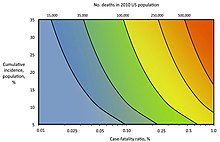

The Pandemic Severity Assessment Framework (PSAF) is an evaluation framework published by the Centers for Disease Control and Prevention in 2016 which uses quadrants to evaluate both the transmissibility and clinical severity of an influenza pandemic and to combine these into an overall impact estimate.[1] Clinical severity is calculated via multiple measures including case fatality rate, case-hospitalization ratios, and deaths-hospitalizations ratios, while viral transmissibility is measured via available data among secondary household attack rates, school attack rates, workplace attack rates, community attack rates, rates of emergency department and outpatient visits for influenza-like illness.[2][3]
The PSAF superseded the 2007 linear Pandemic Severity Index (PSI), which assumed 30% spread and measured case fatality rate (CFR) to assess the severity and evolution of the pandemic.[3][4] The United States Centers for Disease Control and Prevention (CDC) adopted the PSAF as its official pandemic severity assessment tool in 2014,[4] and it was the official pandemic severity assessment tool listed in the CDC's National Pandemic Strategy at the time of the COVID-19 pandemic.[5]
Historically, measures of influenza pandemic severity were based on the case fatality rate.[6] However, the case fatality rate might not be an adequate measure of pandemic severity during a pandemic response because:[2]
To account for the limitations of measuring the case fatality rate alone, the PSAF rates severity of a disease outbreak on two dimensions: clinical severity of illness in infected persons; and the transmissibility of the infection in the population.[2] Each dimension can be measured using more than one measure, which are scaled to facilitate comparison. Having multiple measures for each dimension offers flexibility to choose a measure that is readily available, accurate, and representative of the impact of the pandemic. It also allows comparison across measures for a more complete understanding of the severity. The framework gives commentary on the strengths and limitations of various measures of clinical severity and transmissibility as well as guidelines for scaling them. It also provides examples of assessing past pandemics using the framework.[2]
The original documentation for the PSAF includes the following as potential measures of transmissibility:[2]
The original documentation for the PSAF includes the following as potential measures of clinical severity:[2]

The original developers of the PSAF provided a model for the number of hypothetical deaths in the United States 2010 population of an influenza pandemic using the PSAF. While the axes of the PSAF are scaled measures of transmissibility and clinical severity, this model uses the case-fatality ratio instead of the scaled measure of clinical severity and the cumulative incidence of infection instead of the scaled measure of transmissibility.[2]

During its development, the PSAF was applied to past influenza pandemics and epidemics, resulting in the following assessments:[2]
| Influenza pandemic or flu season | Transmissibility | Clinical Severity |
|---|---|---|
| Spanish flu pandemic | 5 | 7 |
| 1957–1958 influenza pandemic | 4 | 4 |
| 1968 influenza pandemic | 4 | 3 |
| 1977-1978 influenza epidemic | 2 | 2 |
| 2006-2007 flu season | 1 | 1 |
| 2007-2008 flu season | 2 | 3 |
| 2009 swine flu pandemic | 3 | 2 |
A team of Brazilian researchers preliminarily assessed the severity of the COVID-19 pandemic using the PSAF in April 2020 based on Chinese data as at 11 February 2020. In their preliminary assessment, they rate COVID-19's scaled transmissibility at 5 and its scaled clinical severity at 4 to 7, placing the COVID-19 pandemic in the "very high severity" quadrant. This preliminary assessment ranks the COVID-19 pandemic as the most severe pandemic since the 1918 influenza pandemic.[8]
| Human and pandemic coronaviruses | Transmissibility | Clinical Severity |
|---|---|---|
| COVID-19 pandemic | 5 | 4~7 |
This report provides an update to the 2008 framework to reflect experiences with 2009 H1N1 and recent responses to localized outbreaks of novel influenza A viruses. The revised framework also incorporates the recently developed Influenza Risk Assessment Tool (IRAT) (12) and Pandemic Severity Assessment Framework (PSAF) (13)...PSAF replaces the Pandemic Severity Index as a severity assessment tool (13).